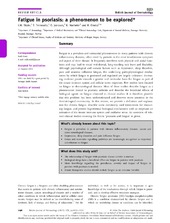Fatigue in psoriasis: a phenomenon to be explored
Peer reviewed, Journal article
Published version

View/
Date
2015-05Metadata
Show full item recordCollections
Original version
British Journal of Dermatology. 2015, 172, 1196-1203. https://doi.org/10.1111/bjd.13647Abstract
Fatigue is a prevalent and substantial phenomenon in many patients with chronic inflammatory diseases, often rated by patients as the most troublesome symptom and aspect of their disease. It frequently interferes with physical and social functions and may lead to social withdrawal, long-standing sick leave and disability. Although psychological and somatic factors such as depression, sleep disorders, pain and anaemia influence fatigue, the underlying pathophysiological mechanisms by which fatigue is generated and regulated are largely unknown. Increasing evidence points towards a genetic and molecular basis for fatigue as part of the innate immune system and cellular stress responses. Few studies have focused on fatigue in dermatological diseases. Most of these studies describe fatigue as a phenomenon related to psoriatic arthritis and describe the beneficial effects of biological agents on fatigue observed in clinical studies. It is therefore possible that this problem has been underestimated and deserves more attention in the dermatological community. In this review, we provide a definition and explanation for chronic fatigue, describe some commonly used instruments for measuring fatigue, and present hypothetical biological mechanisms with an emphasis on activation of the innate immune system and oxidative stress. An overview of relevant clinical studies covering the theme ‘psoriasis and fatigue’ is given.
